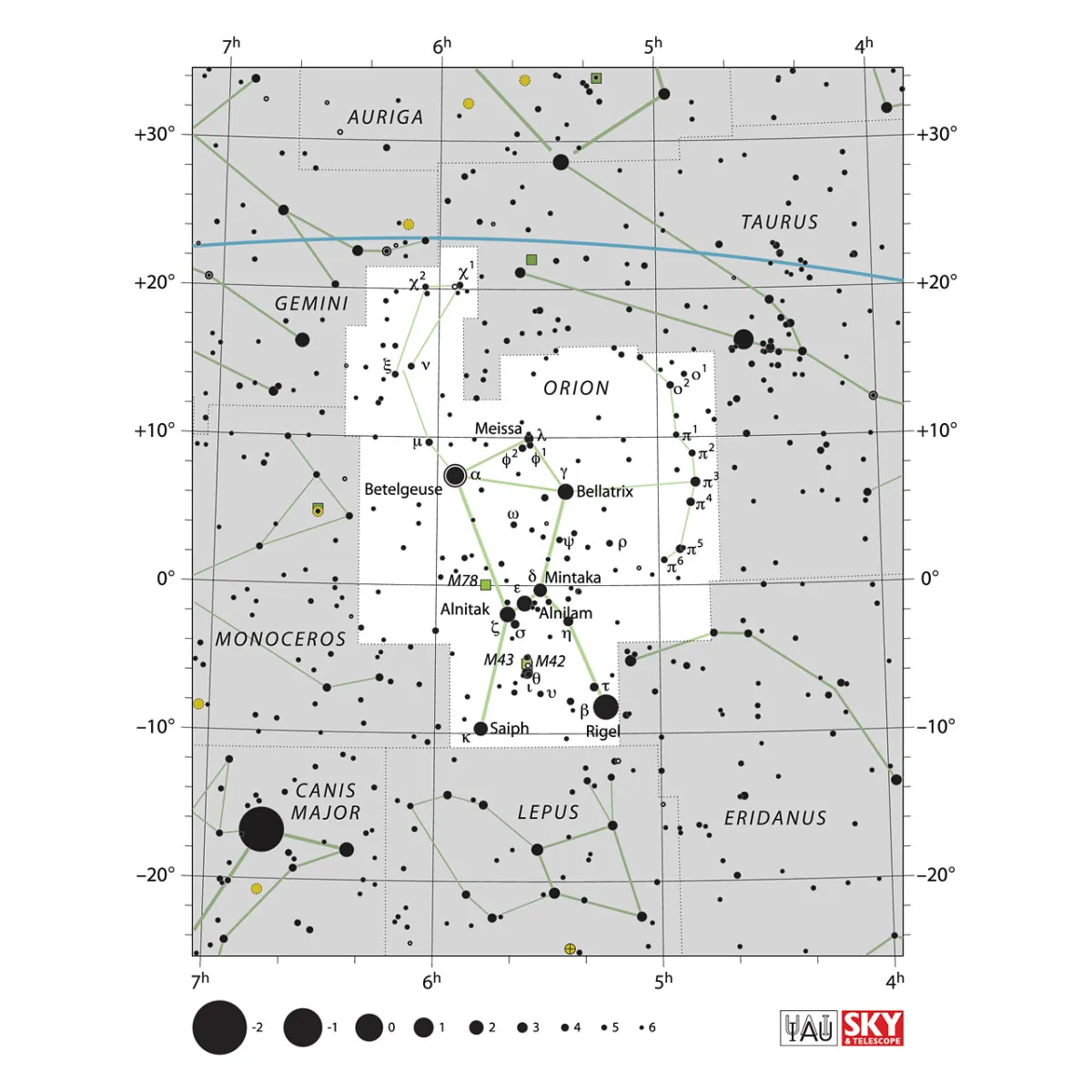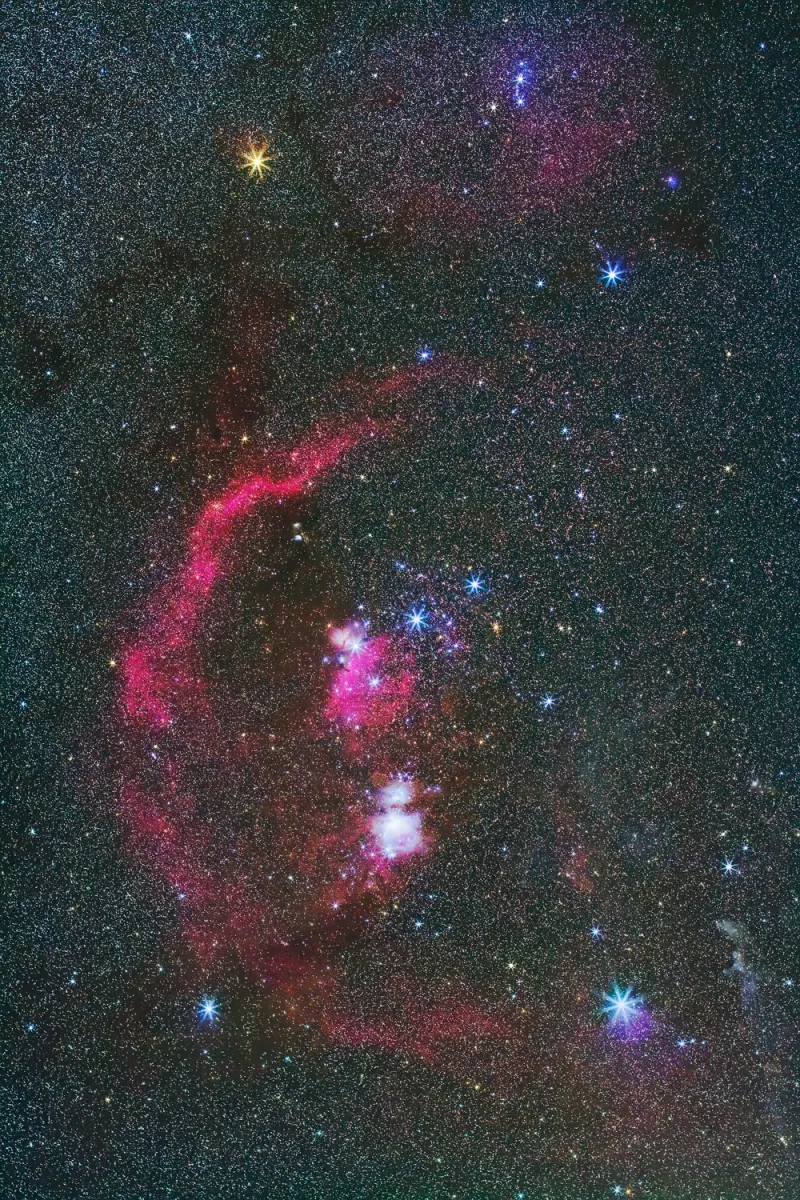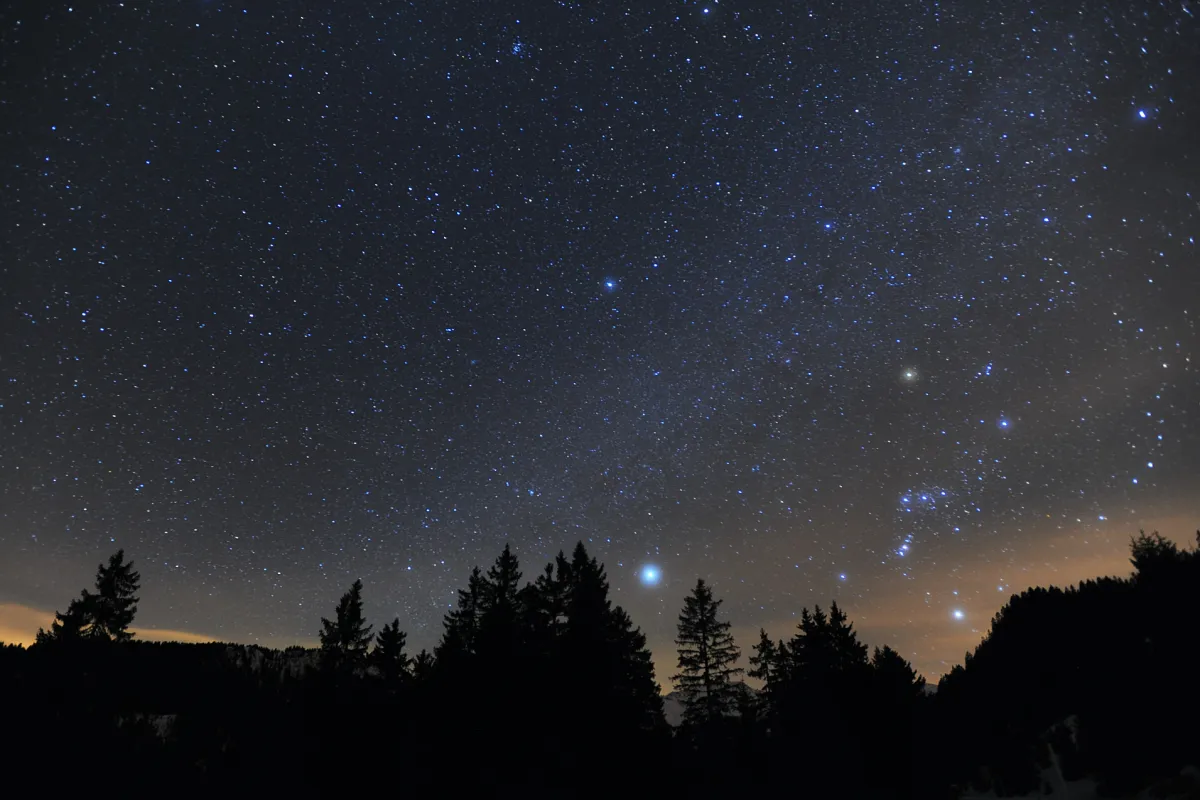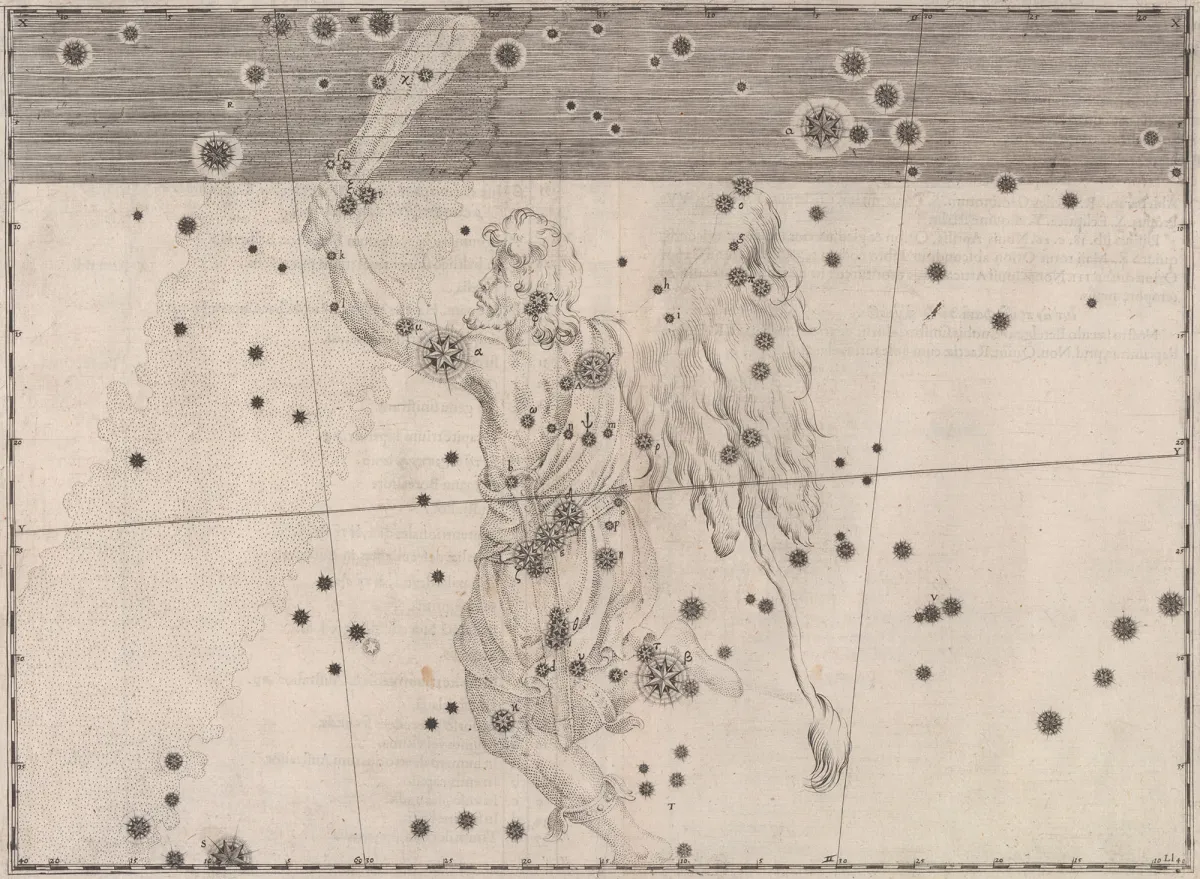Sternbild Orion

Eigenschaften
Das Sternbild Orion ist zweifelsohne das hellste und vielleicht bekannteste am Himmel. Es ist vorallem im Winter am Himmel zu sehen. Nordöstlich schließt das Sternbild Gemini an, nordwestlich Taurus, südwestlich Eridanus, südlich Lepus und östlich Monoceros.
Mit Abstand das auffälligste Merkmal sind die drei hellen Gürtelsterne Alnitak, Alnilam und Mintaka, die in einer Reihe liegen. Aber auch die beiden Schultersterne Betelgeuse und Bellatrix, sowie die Fußsterne Saiph und Rigel sind nicht zu verachten. Sie bilden zusammen mit den Gürtelsternen zwei auffällige Trapeze. Nördlich der beiden Trapeze liegt ein kleines Dreieck aus drei Sternen, welches den Kopf des Orion darstellt. Eine Reihe von schwächeren Sternen und der von bloßem Auge gut erkennbare Orionnebel bilden im südlichen Trapez das Schwert des Orion. Das Sternbild spiegelt also den idealen Krieger wieder: großer Körper mit kleinem Kopf. Orion bedeckt am Firmament eine Fläche von 594 Quadratgrad und kulminiert jeweils etwa am 13. Dezember um Mitternacht.[9, 15]
Orion ist Schauspielplatz eines Sternentstehungsgebietes mit dem etwa 1350 Lichtjahren entfernten Orionnebel als zentralen, hellsten Teil des Orion-Molekülwolkenkomplexes, welcher sich bis über das ganze Sternbild hinweg ausbreitet und aus leuchtenden, reflektierenden wie auch dunklen Wolken zusammensetzt.
| α Ori | Betelgeuse, Betelguex, Betelgeuze, Beteiguex, Al Mankib |
| β Ori | Rigel, Algebar, Elgebar |
| γ Ori | Bellatrix, The Amazon Star |
| δ Ori | Mintaka, Mintika |
| ε Ori | Alnilam, Alnihan, Alnitam |
| ζ Ori | Alnitak, Alnitah |
| ι Ori | Nair Al Saif, Hatysa |
| κ Ori | Saiph |
| λ Ori | Meissa, Heka |
| υ Ori | Thabit, Tabit |
| IAU Name | Orion |
| IAU Genitiv | Orionis |
| IAU Kürzel | Ori |
| Deutscher Name | Orion |
| Kulmination bei lokaler Mitternacht | 16. Dezember |
| Saison (Breitengrad +0.0°) | August … Mai |
| Rektaszension (J2000.0) | 04h 43m 25s … 06h 25m 47s |
| Deklination (J2000.0) | -10° 58' 43" … +22° 52' 35" |
| Fläche | 594 deg2 |
| Nachbarn (N↻) | Gem, Tau, Eri, Lep, Mon |
Deep-Sky Objektbeschreibungen
Barnard 33
Messier 42
NGC 1999
NGC 2023
Nebel
NGC 2024
NGC 2169
NGC 2175
Sh 2-261
Sh 2-276
Nebel
Sh 2-279
Kataloge

Mythologie und Geschichte
Orion ist eine Sagengestalt aus der ältesten Zeit. Er wurde als ein Vorbild eines großen Jägers gesehen, der wegen seiner Schönheit die Liebe von Göttinnen errang, der aber auch selbst Frauen verfolgte und ihnen nachstellte, ohne sie jedoch je zu erreichen. Orion war je zu einem Drittel der Sohn von Zeus, von Poseidon und von Hermes. Er wird auch der "Erdgeborene" genannt. Doch hier zuerst die Geschichte seiner Herkunft:
Zeus, der König der Götter, und Poseidon, der Gott der Meere, und Hermes, der Götterbote, gingen eines Abends zusammen ihres Weges und kamen an der kleinen Hütte des alten Hyreius vorbei. Dieser war ein armer Mann und besaß nur wenig Land das er bebauen konnte. Er stand vor seiner Hütte und lud sie zur Übernachtung ein. Noch erkannte er nicht die Göttlichkeit der dreien, denn sie verbargen sie vor ihm.
Die drei Götter traten in das Haus des Alten, das von dunklem Rauch geschwärzt war. Auf dem Herde glomm nur noch wenig Glut. Hyreius kniete nieder, fachte neues Feuer an und brachte zwei Töpfe mit Bohnen und Kohl zum kochen. Mit zittriger Hand bot er seinen Gästen roten Wein an. Poseiden erhielt als erster den Becher, leerte ihn und sprach: «Gib, dass jetzt Zeus als nächster trinkt.» Der alte Mann wurde bleich, als er den Namen vernahm, doch er fasste sich. Dann schlachtete er seinen einzigen Stier, den er zum pflügen seines kargen Ackers brauchte und briet ihn an einem mächtigen Feuer. Er holte anderen Wein hervor, den er in einem rauchgeschwärzten Krug aufbewahrte und ihn einst in jungen Jahren abgefüllt hatte. Die drei Götter setzten sich ohne zu zögern auf die niedrige Lagerstätte, welche nur aus mit einem Leinentuch bedeckten Flussschilf bestand.

Die Tafel strahlte bald von dem Fleisch und dem Wein, der aufgetischt wurde. Der Mischkrug war ein rotes irdenes Gefäß, die Becher waren aus Buchenholz. Zeus war gerührt von der Aufopferung des alten Hyreius und sagte: «Wenn du etwas verlangst, so wünsche! Du wirst alles erhalten.» Der friedliche alte Mann erzählte von seiner geliebten, kürzlich verstorbenen Frau und seinem sehnlichsten Wunsch, Vater zu werden.
Zeus, Poseidon und Hermes stimmten ihm zu und alle traten sie an die abgezogene, frische Haut des Stieres. Sie entleerten daran ihre Blase und deckten dann die feuchte Haut zu, indem sie Erde darauf warfen. Es dauerte zehn Monate, da entstand daraus ein Kind. Hyreius nannte es Urion, weil es so gezeugt war. Der Knabe wuchs sehr schnell heran und ward schön und kräftig. Mit der Zeit hat jedoch der erste Buchstabe seines Namens seinen alten Klang verloren und er ward fortan Orion genannt. [20]
Orion jagte einst eine wilde Bestie im Königreich Chios, dessen Herrscher eine wunderschöne Tochter besaß. Orion fragte ihn, ob er sie h eiraten dürfe, doch der König wollte nicht einen solch furchterregenden Schwiegersohn. Er trickste Orion aus, indem er ihn erst betrunken machte und dann blind machte. Orion, beraubt seinem Augenlicht, folgte dem Klange der schlagenden Hammer des Schmiedegottes Hephaistos. Der Hufschmied gab dem Jäger seinen Assistenten, einen hinkenden Zyklopen namens Cedalion. Orion trug Cedalion auf seinen Schultern und Cedalion lieh Orion sein mächtiges Augenlicht. Er half ihm letzendlich ein Land im "Osten des Ostens" zu finden. Dort heilte die aufgehende Sonne die Augen des Orion. [65]
Der Orion hatte in seiner Schönheit und Mächtigkeit sogar Göttinnen zu fesseln gewusst. Delia erkor ihn sich zum Begleiter, er war der Schützer der Göttin und ihr Gefolgsmann. Nach Homers Bericht war da die Göttin der Morgenröte, Eos (lat. Aurora), die in ihrer unausgesetzten Verliebtheit den Orion zu gewinnen wusste. Doch auch die Töchter des Atlas, dem Träger des Himmelsgewölbes, waren mit ihm verbunden. Sie waren die Plejaden, die der Orion liebte, sie aber nie erreichte. Bis heute eilt er Nacht für Nacht am Himmel nach, ohne sie je einzuholen. Sogar die jungfräuliche Göttin der Jagd, Artemis (auch Mondgöttin) war von Orion geblendet und tötete ihn zuletzt mit Pfeilen aus Missgunst und Eifersucht. Im nachhinein hört man dann auch eine andere, etwas abgeschwächte Version, nach der Orion sterben musste, weil er zu viele Tiere erlegte - denn schließich ist ja die Göttin der Jagd auch die Schützerin aller wilden Tiere. [20]

Nach einer anderen Todesversion erregte die Beziehung zwischen Orion und Artemis die Eifersucht ihres Zwillingsbruders, dem Sonnengott Apollo. Eines Tages standen Apollo und Artemis an einem Strand und er forderte sie auf, ein dunkles Objekt, weit weg auf dem Meer zu treffen. Dieses Objekt war der Kopf des Orion, sichtbar über den Wellen wie er auf dem Grund des Ozeans ging. Artemis' Pfeil tötete Orion. Um Sie zu trösten gewährte Zeus dem Jäger einen Platz unter den Sternen. [65]
Eine weitere Todesversion wird erzählt, in welcher der Skorpion vorkommt. Hera, die eifersüchtige Gattin des Zeus, sandte den Skorpion um Orion zu töten. Noch heute steht Orion nur dann am Himmel, wenn der Skorpion bereits untergegangen ist. [20, 65]
Der Orion war als Riese, Jäger und Krieger bekannt. Der römische Dichter Catull transkribierte die griechische Bezeichnung in das Wort Oarion. Nach Ovids Erzählung ist auch Urion gebrächlich, sowie die Namen Deanae Comes und Amasius, die darauf anspielen, dass der Orion der Begleiter und der Geliebte der Diana war.
Im ägyptischen Kulturkreis steht das viel beachtete Sternbild den Göttern Horus und Osiris nahe. Nach ägyptischen Mythen ist Osiris von seinem Bruder Seth, einem zwielichtigen, altägyptischen Gott, ermordet, zerstückelt und verstreut worden. Isis, die Schwester Osiris', hat den toten Bruder gesucht, ja gleichsam aufgesammelt und wiederbelebt. Sie hat dann von ihm ihren Sohn Horus empfangen, der später das Erbe des Osiris antrat. Osiris war im Reich der Toten Richter und Herrscher und ließ als Vegetationsgott Pflanzen aus der Erde sprießen und gedeihen.
Aus der jüdischen Tradition stammt eine Identifikation mit Nimrod, einer alttestamentarischen Gestalt, die als großer Jäger gesehen wurde. Auf ihn soll die Gründung Babyloniens und Assyriens zurückgehen. Das Bild des Jägers gibt es für Orion auch im römischen Kulturraum, er wurde Venator genannt.
Indiander aus Zentralbrasilien sehen im Orion ein Großes Gestell auf dem Maniok getrocknet wird. Maniok ist ein Wurzeknollengewächs, aus dem Stärkemehl gewonnen wird, welches das wichtigste Nahrungsmittel ist. In dieses Bild war auch der Sirius einbezogen. [20, 56]